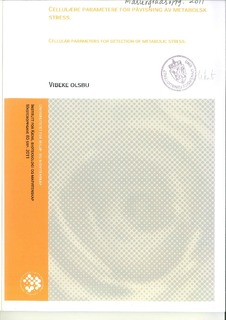| dc.description.abstract | Unfolded protein respons (UPR) er en cellulær stressrespons som blir aktivert dersom endoplasmatisk retikulum (ER) blir utsatt for stress i form av ufoldede proteiner. Dersom mengden ufoldede proteiner er høyere enn foldingskapasiteten til ER, blir UPR aktivert. Det finnes også andre faktorer enn ufoldede proteiner som kan aktivere UPR. Disse faktorene kan være uregelmessigheter i glukosenivået, enkelte lipider, ubalanse i kalsiumnivået, hypoksi og patogener.
I eukaryote celler er overvåkningen av ER lumen og UPR-signaler mediert av tre ulike membranassosierte proteiner, PERK (PKR-like eukaryotic initation factor 2α kinase), IRE1 (inositol requiring enzyme 1) og ATF6 (activating transcription factor-6). De fungerer som stressensorer i ER lumen, og i et velfungerende og stressfritt ER er disse transmembranproteinene bundet av et anstandsprotein, BiP (binding immunoglobulin protein), i det intralumenale domenet. Når disse proteinene er bundet sammen, forblir de inaktive. Dersom det forekommer en akkumulering av ufoldede proteiner i ER, løsner BiP fra UPR-sensorene. Dette skjer fordi de ufoldede proteinene konkurrerer med sensorproteinene om binding til BiP.
I denne oppgaven ble TERT og 293T celler stimulert med tunicamycin og thapsigargin for å indusere UPR. Hensikten med denne oppgaven var å lage et system for detektering av UPR, og det ble sett på proteinene PERK, eIF2α (Eukaryotic Initiation Factor 2 alpha) og ATF4 (Activating transcription factor 4) i PERK-signalveien. Det ble også sett på IL-8 produksjon i TERT celler etter stimulering med thapsigargin. Resultatene viste at eIF2α blir fosforylert ved stimulering med thapsigargin, noe som tyder på at UPR har blitt aktivert med denne stimuleringen. Målingene av cytokinproduksjon viste økt produksjon av IL-8 etter stimulering med thapsigargin, og dette indikerer også at cellene responderer på stimulering med thapsigargin. Det ble ikke sett noen fosforylering av PERK, og heller ingen økt translasjon av ATF4 etter stimulering, disse resultatene indikerer at UPR ikke er aktivert. Det er likevel grunn til å tro at årsaken til at det ikke ble påvist fosforylering av PERK eller økt translasjon av ATF4, skyldes feil i deteksjonssystemene som ble brukt. The unfolded protein response is a cellular stress response activated in response to the accumulation of unfolded proteins in the ER lumen. Other conditions exist that can also activate the UPR. These conditions include an imbalance in ER calcium levels, glucose and energy deprivation, hypoxia, pathogens and certain lipids.
In eukaryotic cells, the ER lumen and UPR signals are mediated by three different membrane associated protein, Perk (PKR-like eukaryotic initation factor 2α kinase), IRE1 (Inositol requiring enzyme 1) and ATF6 (Activating transcription factor-6). They act as stress sensors in the ER lumen, and in an efficient and stress-free ER, these transmembrane proteins are bound by a chaperone, BIP (immunoglobulin binding protein), in the intraluminal domain. When these proteins are bound together, they remain inactive. In a well-functioning and “stress-free” ER, these three transmembrane proteins are bound by a chaperone, BiP, in their intralumenal domains and rendered inactive. Accumulation of improperly folded proteins and increased protein cargo in the ER results in the recruitment of BiP away from these UPR sensors.
TERT and 293T cells were stimulated with tunicamycin and thapsigargin to induce the UPR. The purpose of this thesis was to create a system for detecting the UPR. Three proteins in the PERK pathway were examined; PERK, eIF2α (eukaryotic initiation factor 2 alpha) and ATF4 (Activating transcription factor 4). It was also examined whether stimulation with thapsigargin resulted in increased IL-8 production. The results showed that eIF2α becomes phosphorylated by stimulation with thapsigargin, suggesting that the UPR has been activated with this stimulation. No phosphorylation of PERK was detected, nor was any increased translation of ATF4 after stimulation observed. These latter results indicate that UPR is not activated. However, there is reason to believe that these results were due to problems with the detection system which were used. | no_NO |
